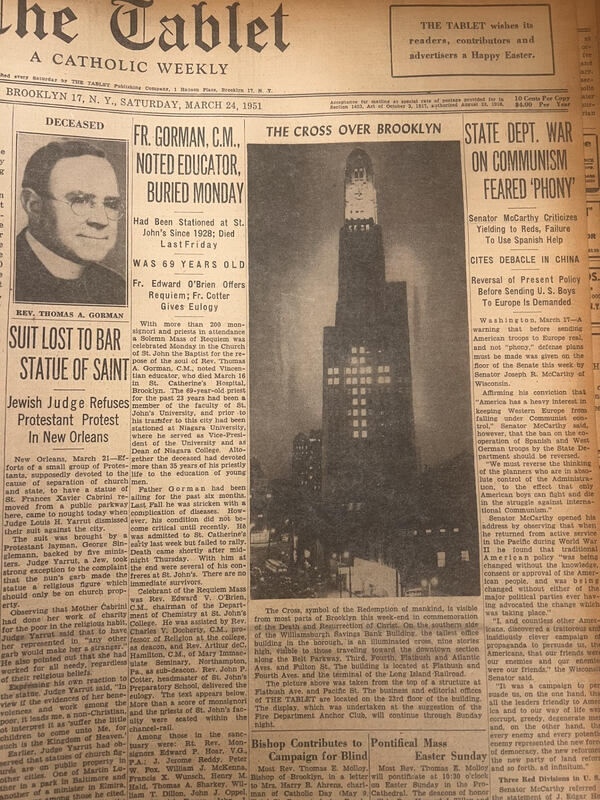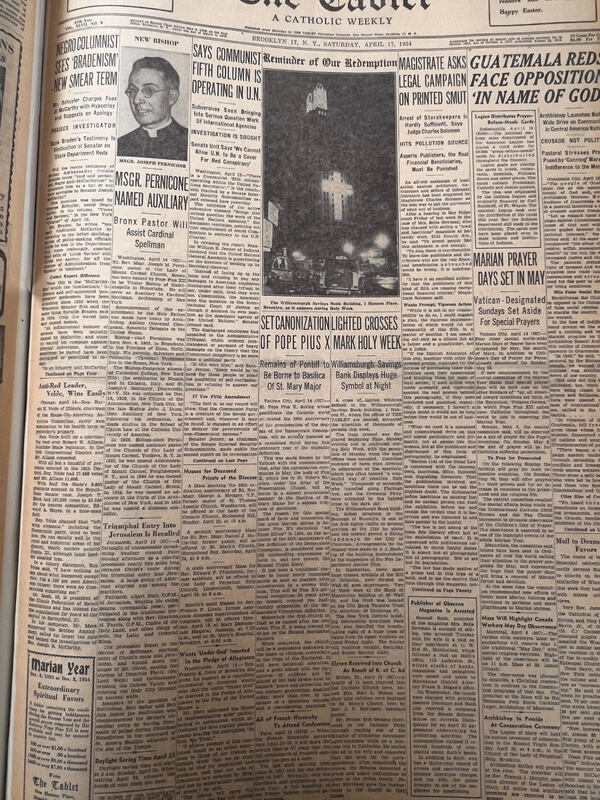
GREENPOINT — Ed Wilkinson remembers growing up in Greenpoint in the 1950s, and gazing across the East River on Good Friday to see three consecutive Manhattan skyscrapers all with lighted windows in the shape of crosses.
“We were right on the water. If you went down to the river, you could see those buildings all lit up. If you went up to the rooftops, you could see them,” recalled Wilkinson, editor emeritus of The Tablet. “Those buildings were a great public expression of faith.”
The Tablet documented many of them.
The front page of the March 24, 1951 edition of The Tablet featured a photo of the Williamsburg Savings Bank at 1 Hanson Pl. in downtown Brooklyn with its windows lighted in the shape of a cross. This newspaper’s offices were on the 23rd floor.
The Tablet’s front page on April 5, 1952 contained an article with the lede, “On Good Friday Night, New Yorkers will witness one of the most impressive displays in commemoration of the Death of Christ that this city has ever seen.”
The article went on to explain that three buildings in the financial district — Irving Trust Co. at 1 Wall Street, the Bank of Manhattan at 40 Wall Street and City Bank-Farmers Trust at 20 Exchange Pl. — would light their windows to create crosses. The idea for the illuminated crosses was generated by the Catholic Action Committee of the Fire Department Anchor Club, a group composed of members of the Knights of Columbus.
In the same article, The Tablet reported that the Williamsburg Savings Bank would also display an illuminated cross.

It’s not clear when the tradition began.
According to The Tablet’s archives, the first mention of it was in 1951. The crosses were featured on the front page every year until 1956.
The idea of having crosses on office buildings is not something Bishop Emeritus Nicholas DiMarzio can imagine today. Religion is “not part of the culture,” he said.
“I think that’s the major problem — that our culture has become secularized,” Bishop DiMarzio said. “It’s not favorable toward religion as it once was. … It’s just that religion is really a non-entity in many ways in the culture. Culture supports belief, or it detracts from belief. That’s all part of this issue.”
Although, expressions of faith were part of the fabric of life in New York decades ago, according to Catholics who spoke to The Tablet and shared their memories of past Easters.
Father Dominick Cutrone, who lives at Our Lady of Grace Church in Gravesend, was ordained in 1955 and is marking 70 years as a priest. He remembers hearing about the skyscrapers with crosses, just as he remembers a time when religion was more intertwined with secular life.
For example, “Blue Laws” in New York State mandated stores close on Sundays.
“I’ll never forget one time when I was first a priest, probably around Easter time, I went with friends to Paramus, New Jersey, to eat, and the stores there were open on a Sunday. I bought a T-shirt and felt so guilty that I had broken the Blue Laws,” he said.
The Easters of Father Cutrone’s childhood in the 1930s are memories that stay with him today. He can still taste his mother Lena’s homemade pasta.
“We used to help knead the dough,” Father Cutrone said. Lena was also famous for her Pizza Dolce, a type of Italian cheesecake made with ricotta, he noted.
Joan DeRiso vividly remembers that stores would be just as likely to have crosses in their windows as the Easter Bunny. She has fond memories of the Easter Sunday Masses she attended at Nativity of the Blessed Virgin Mary Church growing up in Ozone Park in the 1940s.
“We always had a new outfit to go to Mass. You were supposed to wear your new clothes to church first. The first time you wore them, you’re supposed to go to church with them — your dress, your little bonnet, your gloves and your spring coat,” said DeRiso, now a parishioner of St. Helen Church in Howard Beach.
Wilkinson, who also remembered getting a new Easter suit every year to wear to St. Alphonsus Church, recalled how he spent Good Fridays.
In the morning, he said he and his friends visited churches.
“There was a custom of visiting seven churches. That was easy for us in Greenpoint, because we had a lot of churches fairly close,” Wilkinson said, adding that St. Alphonsus, St. Anthony and Sts. Cyril and Methodius were among the stops.

The afternoon was solemn, he said.
“On Good Friday, we had no television and no radio from 12 p.m. to 3 p.m. Those were sacred hours,” Wilkinson said, referring to the hours Christ spent on the cross.
While crosses are no longer prevalent on buildings, Bishop DiMarzio said he sees signs of a faith revival.
“We put the Christmas creche at Grand Army Plaza. That’s something that wasn’t there before, and we got the support of the city to do it,” he noted. “So, there’s some positive things happening.”
DeRiso is hopeful that faith will again be part of secular life.
“Look at all of the immigrants coming here. They have religious processions through the streets all of the time. Religion is coming back,” she said.
